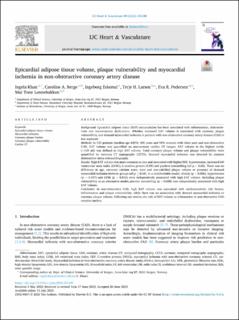Epicardial adipose tissue volume, plaque vulnerability and myocardial ischemia in non-obstructive coronary artery disease
Khan, Ingela; Berge, Caroline Annette; Eskerud, Ingeborg; Larsen, Terje Hjalmar; Pedersen, Eva Ringdal; Lønnebakken, Mai Tone
Journal article, Peer reviewed
Published version

Åpne
Permanent lenke
https://hdl.handle.net/11250/3117370Utgivelsesdato
2023Metadata
Vis full innførselSamlinger
- Department of Clinical Science [2295]
- Registrations from Cristin [9489]
Originalversjon
International journal of cardiology: Heart and Vasculature (IJCHA). 2023, 49, 101240. 10.1016/j.ijcha.2023.101240Sammendrag
Background
Epicardial adipose tissue (EAT) accumulation has been associated with inflammation, atherosclerosis and microvascular dysfunction. Whether increased EAT volume is associated with coronary plaque vulnerability and demand myocardial ischemia in patients with non-obstructive coronary artery disease (CAD) is less explored.
Methods
In 125 patients (median age 63[58, 69] years and 58% women) with chest pain and non-obstructive CAD, EAT volume was quantified on non-contrast cardiac CT images. EAT volume in the highest tertile (>125 ml) was defined as high EAT volume. Total coronary plaque volume and plaque vulnerability were quantified by coronary CT angiography (CCTA). Demand myocardial ischemia was detected by contrast dobutamine stress echocardiography.
Results
High EAT volume was more common in men and associated with higher BMI, hypertension, increased left ventricular mass index (LVMi), C-reactive protein (CRP) and positive remodelling (all p < 0.05). There was no difference in age, coronary calcium score, total and non-calcified plaque volume or presence of demand myocardial ischemia between groups (all p ≥ 0.34). In a multivariable model, obesity (p = 0.006), hypertension (p = 0.007) and LVMi (p = 0.016) were independently associated with high EAT volume. Including plaque vulnerability in an alternative model, positive remodelling (p = 0.038) was independently associated with high EAT volume.
Conclusion
In non-obstructive CAD, high EAT volume was associated with cardiometabolic risk factors, inflammation and plaque vulnerability, while there was no association with demand myocardial ischemia or coronary plaque volume. Following our results, the role of EAT volume as a biomarker in non-obstructive CAD remains unclear.
